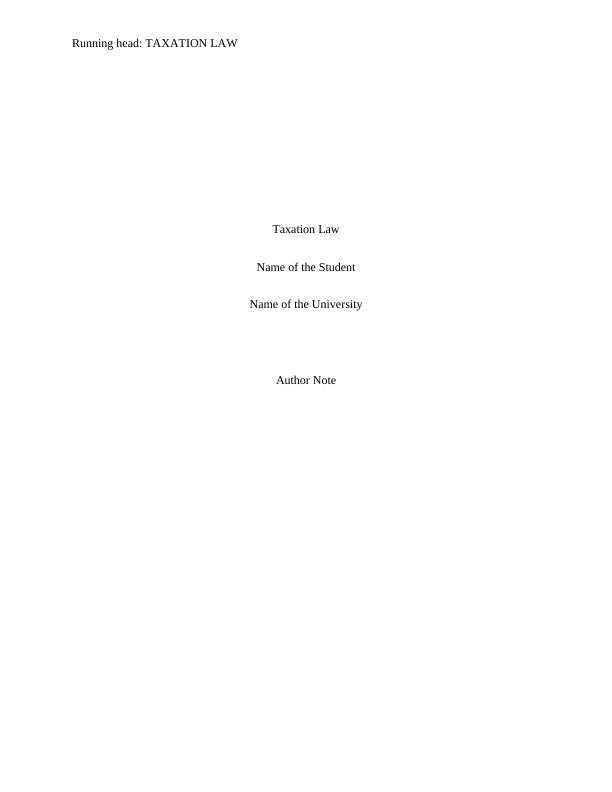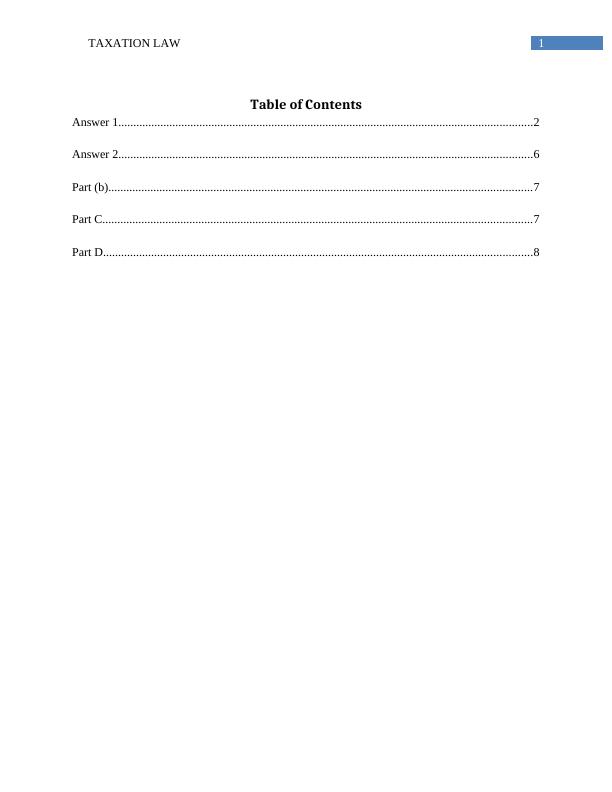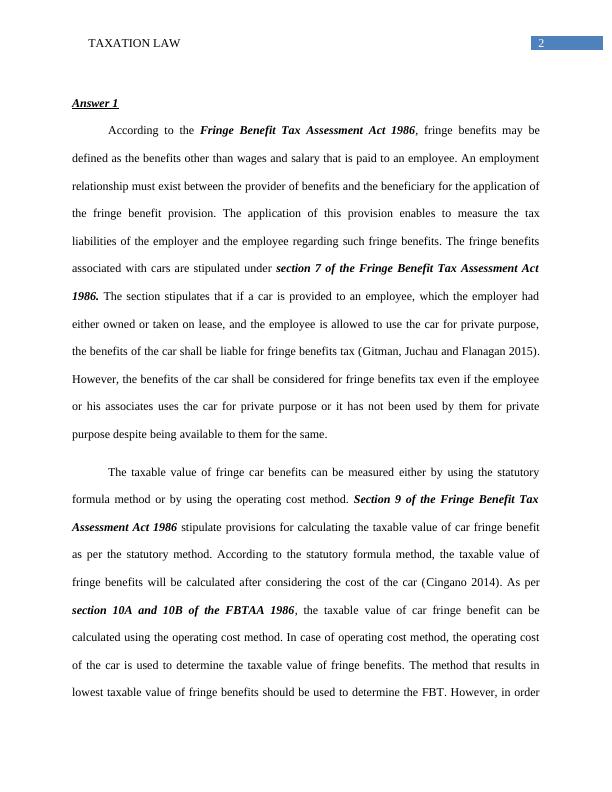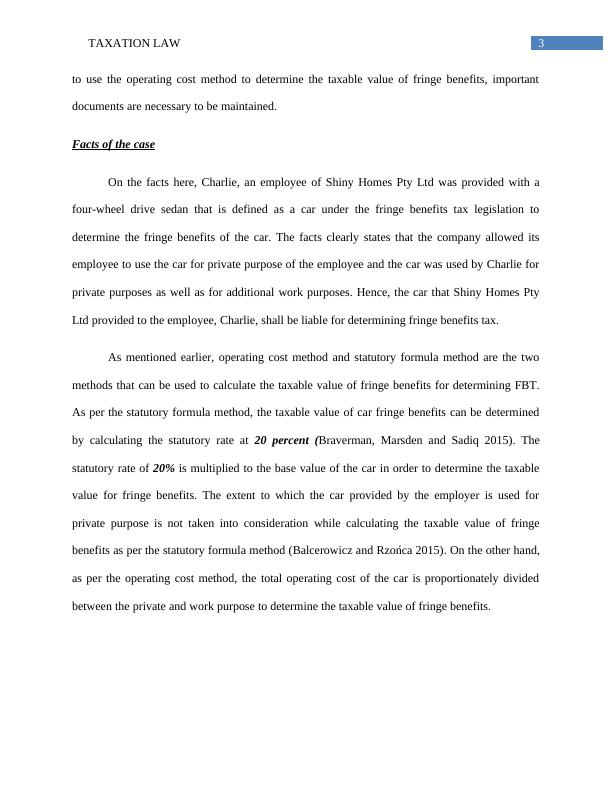Benefits Tax Assessment Act 1986
13 Pages2290 Words68 Views
Added on 2020-05-16
Benefits Tax Assessment Act 1986
Added on 2020-05-16
ShareRelated Documents
Running head: TAXATION LAWTaxation LawName of the StudentName of the UniversityAuthor Note

1TAXATION LAWTable of ContentsAnswer 1..........................................................................................................................................2Answer 2..........................................................................................................................................6Part (b).............................................................................................................................................7Part C...............................................................................................................................................7Part D...............................................................................................................................................8

2TAXATION LAWAnswer 1According to the Fringe Benefit Tax Assessment Act 1986, fringe benefits may bedefined as the benefits other than wages and salary that is paid to an employee. An employmentrelationship must exist between the provider of benefits and the beneficiary for the application ofthe fringe benefit provision. The application of this provision enables to measure the taxliabilities of the employer and the employee regarding such fringe benefits. The fringe benefitsassociated with cars are stipulated under section 7 of the Fringe Benefit Tax Assessment Act1986. The section stipulates that if a car is provided to an employee, which the employer hadeither owned or taken on lease, and the employee is allowed to use the car for private purpose,the benefits of the car shall be liable for fringe benefits tax (Gitman, Juchau and Flanagan 2015).However, the benefits of the car shall be considered for fringe benefits tax even if the employeeor his associates uses the car for private purpose or it has not been used by them for privatepurpose despite being available to them for the same. The taxable value of fringe car benefits can be measured either by using the statutoryformula method or by using the operating cost method. Section 9 of theFringe Benefit TaxAssessment Act 1986 stipulate provisions for calculating the taxable value of car fringe benefitas per the statutory method. According to the statutory formula method, the taxable value offringe benefits will be calculated after considering the cost of the car (Cingano 2014). As persection 10A and 10B of the FBTAA 1986, the taxable value of car fringe benefit can becalculated using the operating cost method. In case of operating cost method, the operating costof the car is used to determine the taxable value of fringe benefits. The method that results inlowest taxable value of fringe benefits should be used to determine the FBT. However, in order

3TAXATION LAWto use the operating cost method to determine the taxable value of fringe benefits, importantdocuments are necessary to be maintained. Facts of the caseOn the facts here, Charlie, an employee of Shiny Homes Pty Ltd was provided with afour-wheel drive sedan that is defined as a car under the fringe benefits tax legislation todetermine the fringe benefits of the car. The facts clearly states that the company allowed itsemployee to use the car for private purpose of the employee and the car was used by Charlie forprivate purposes as well as for additional work purposes. Hence, the car that Shiny Homes PtyLtd provided to the employee, Charlie, shall be liable for determining fringe benefits tax. As mentioned earlier, operating cost method and statutory formula method are the twomethods that can be used to calculate the taxable value of fringe benefits for determining FBT.As per the statutory formula method, the taxable value of car fringe benefits can be determinedby calculating the statutory rate at 20 percent (Braverman, Marsden and Sadiq 2015). Thestatutory rate of 20% is multiplied to the base value of the car in order to determine the taxablevalue for fringe benefits. The extent to which the car provided by the employer is used forprivate purpose is not taken into consideration while calculating the taxable value of fringebenefits as per the statutory formula method (Balcerowicz and Rzońca 2015). On the other hand,as per the operating cost method, the total operating cost of the car is proportionately dividedbetween the private and work purpose to determine the taxable value of fringe benefits.

End of preview
Want to access all the pages? Upload your documents or become a member.
Related Documents
Fringe Benefit Tax Assessment Act 1986: Taxation Lawlg...
|12
|2130
|63
HI6028 Assignment Taxation Law - Fringe Benefitslg...
|10
|1595
|150
Case Study - Taxation Lawlg...
|10
|1748
|51
Fringe Benefit tax Assessment Act 1986 : Case Studylg...
|11
|1700
|91
Tax Assessment Act 1986 | Taxationlg...
|12
|2474
|56
Tax assessment Act 1986 - Assignmentlg...
|9
|1574
|58
